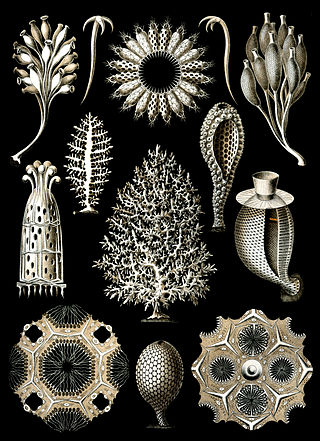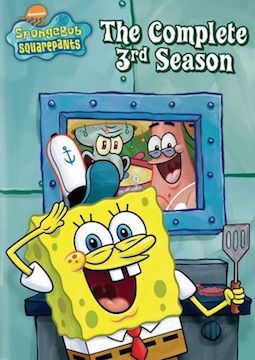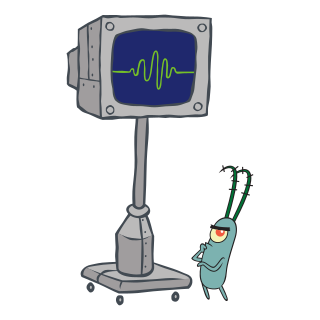
Sponges or sea sponges are primarily marine invertebrates of the metazoan phylum Porifera, a basal animal clade and a sister taxon of the diploblasts. They are sessile filter feeders that are bound to the seabed, and are one of the most ancient members of macrobenthos, with many historical species being important reef-building organisms.

Hexactinellid sponges are sponges with a skeleton made of four- and/or six-pointed siliceous spicules, often referred to as glass sponges. They are usually classified along with other sponges in the phylum Porifera, but some researchers consider them sufficiently distinct to deserve their own phylum, Symplasma. Some experts believe glass sponges are the longest-lived animals on earth; these scientists tentatively estimate a maximum age of up to 15,000 years.

SpongeBob SquarePants is a fictional character and the protagonist of Nickelodeon's eponymous American animated television series. Voiced by Tom Kenny, he is characterized by his optimism and childlike attitude. SpongeBob is a denizen of Bikini Bottom, where he regularly gets into absurd and humorous scenarios.

Mrs. Penelope "Poppy" Puff is a fictional character in the Nickelodeon animated television series SpongeBob SquarePants and all three films based on the franchise. Voiced by Mary Jo Catlett, Mrs. Puff debuted in the season one episode "Boating School" on August 7, 1999. Mrs. Puff was created and designed by marine biologist and animator Stephen Hillenburg. He developed the character in response to a request from Nickelodeon that the show star a schoolteacher. Hillenburg did not want to portray SpongeBob as a school-age child, so Mrs. Puff was introduced as his driving instructor instead of an elementary school teacher.

Sandy Cheeks is a fictional character in the American animated comedy television series SpongeBob SquarePants and the Nickelodeon franchise of the same name. She is voiced by Carolyn Lawrence and first appeared in the episode "Tea at the Treedome", which premiered on May 1, 1999. She was created and designed by marine biologist and animator Stephen Hillenburg who is also the creator of the series. Sandy is portrayed as an intelligent anthropomorphic flying squirrel who wears an astronaut-like diving suit and lives underwater.

The calcareoussponges are members of the animal phylum Porifera, the cellular sponges. They are characterized by spicules made of calcium carbonate, in the form of high-magnesium calcite or aragonite. While the spicules in most species are triradiate, some species may possess two- or four-pointed spicules. Unlike other sponges, calcareans lack microscleres, tiny spicules which reinforce the flesh. In addition, their spicules develop from the outside-in, mineralizing within a hollow organic sheath.

Kalymnos is a Greek island and municipality in the southeastern Aegean Sea. It belongs to the Dodecanese island chain, between the islands of Kos and Leros : the latter is linked to it through a series of islets. Kalymnos lies between two and five hours away by sea from the island of Rhodes.

Stephen McDannell Hillenburg was an American animator, voice actor, and marine biology educator. Hillenburg was best known for creating the animated television series SpongeBob SquarePants for Nickelodeon in 1999. Serving as the showrunner for its first three seasons, and again from season nine until his death, the show has become the fifth-longest-running American animated series. He also provided the original voice of Patchy the Pirate's pet, Potty the Parrot.

Demosponges (Demospongiae) are the most diverse class in the phylum Porifera. They include greater than 90% of all species of sponges with nearly 8,800 species worldwide. They are sponges with a soft body that covers a hard, often massive skeleton made of calcium carbonate, either aragonite or calcite. They are predominantly leuconoid in structure. Their "skeletons" are made of spicules consisting of fibers of the protein spongin, the mineral silica, or both. Where spicules of silica are present, they have a different shape from those in the otherwise similar glass sponges. Some species, in particular from the Antarctic, obtain the silica for spicule building from the ingestion of siliceous diatoms.

SpongeBob SquarePants is an American animated television series created by marine science educator and animator Stephen Hillenburg for Nickelodeon. It first aired as a sneak peek after the 1999 Kids' Choice Awards on May 1, 1999, and officially premiered on July 17, 1999. It chronicles the adventures of SpongeBob SquarePants and his aquatic friends in the underwater city of Bikini Bottom.

Sticky toffee pudding, known as sticky date pudding in Australia and New Zealand, is a British dessert consisting of a moist sponge cake covered in a toffee sauce, often served with a vanilla custard or vanilla ice cream. It is widely served in the Lake District in northwest England, where it is a culinary symbol.

The banded sand catshark is a coloured catshark belonging to the family Atelomycteridae found in the Indo-West Pacific Ocean, endemic to northern Australia between latitudes 10° S and 21° S, at depths between 27 and 120 metres. Its length is up to 45 centimetres (18 in). They were the first sharks to be discovered living in sponges.

The second season of the American animated television series SpongeBob SquarePants, created by Stephen Hillenburg, aired on Nickelodeon from October 20, 2000, to July 26, 2003, and consists of 20 half-hour episodes. The series chronicles the exploits and adventures of the title character and his various friends in the fictional underwater city of Bikini Bottom. The season was executive produced by series creator Hillenburg, who also acted as the showrunner.

The third season of the American animated television series SpongeBob SquarePants, created by Stephen Hillenburg, aired on Nickelodeon from October 5, 2001, to October 11, 2004, and consists of 20 half-hour episodes. The series chronicles the exploits and adventures of the title character and his various friends in the fictional underwater city of Bikini Bottom. The season was executive produced by series creator Hillenburg and supervising produced by Derek Drymon, who also acted as the showrunner. Hillenburg halted production on the show to work on the 2004 film adaptation of the series, The SpongeBob SquarePants Movie. After production on the film, Hillenburg resigned from the show as its showrunner, and appointed staff writer, Paul Tibbitt, to overtake the position. Season three was originally set to be the final season of the series, with the film acting as a series finale, but its success prevented the series from ending, leading to a fourth season.

Sponge cake is a light cake made with eggs, flour and sugar, sometimes leavened with baking powder. Some sponge cakes do not contain egg yolks, like angel food cake, but most of them do. Sponge cakes, leavened with beaten eggs, originated during the Renaissance, possibly in Spain. The sponge cake is thought to be one of the first non-yeasted cakes, and the earliest attested sponge cake recipe in English is found in a book by the British poet Gervase Markham, The English Huswife, Containing the Inward and Outward Virtues Which Ought to Be in a Complete Woman (1615). Still, the cake was much more like a cracker: thin and crispy. Sponge cakes became the cake recognised today when bakers started using beaten eggs as a rising agent in the mid-18th century. The Victorian creation of baking powder by British food manufacturer Alfred Bird in 1843 allowed the addition of butter to the traditional sponge recipe, resulting in the creation of the Victoria sponge. Cakes are available in many flavours and have many recipes as well. Sponge cakes have become snack cakes via the Twinkie.

Patrick Star is a fictional character in the American animated television series SpongeBob SquarePants. He is voiced by actor Bill Fagerbakke and was created and designed by marine biologist and animator Stephen Hillenburg. He first appeared in the series' pilot episode "Help Wanted" on May 1, 1999. In addition to his supporting role on SpongeBob SquarePants, Patrick also serves as the main protagonist of The Patrick Star Show, which premiered in 2021.
John N.A. Hooper is an Australian marine biologist and writer on science. He is the current Head of Biodiversity & Geosciences Programs at the Queensland Museum. His research has included studying the possible medical benefits of marine sponges, including beta blockers for heart disease, and for compounds to combat illnesses like gastro-intestinal disease and cancer. In 2007 he was a member of the Discussion Panel On Marine Genetic Resources for the eighth annual United Nations Informal Consultative Process for Oceans and the Law of the Sea (UNICPOLOS).

Sheldon J. Plankton and Karen Plankton are a pair of fictional characters and the main antagonists of SpongeBob SquarePants, the Nickelodeon animated television series. They are voiced by Mr. Lawrence and Jill Talley, respectively. Their first appearance was in the episode "Plankton!", which premiered on July 31, 1999. They were created and designed by the marine biologist and animator Stephen Hillenburg, the creator of the series. Hillenburg named Karen after his wife, Karen Hillenburg.
Phyllis Jane Fromont is a New Zealand and Australian scientist specialising in sponges.
















